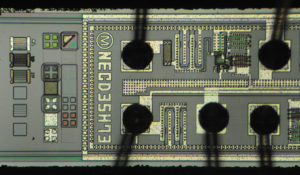Extract Microcontroller PIC18F4331 Firmware
Extract Microcontroller PIC18F4331 Firmware from its flash and eeprom memory, then copy the program and data to other blank MCU PIC18F4331 which will provide the exactly same functions as originals;

Extract Microcontroller PIC18F4331 Firmware from its flash and eeprom memory, then copy the program and data to other blank MCU PIC18F4331 which will provide the exactly same functions as originals
All of the devices in the PIC18F4331 family offer nine different oscillator options, allowing users a wide range of choices in developing application hardware. These include:
· Four crystal modes, using crystals or ceramic resonators.
· Two external clock modes, offering the option of using two pins (oscillator input and a divide-by-4 clock output) or one pin (oscillator input, with the second pin reassigned as general I/O).
· Two external RC oscillator modes, with the same pin options as the external clock modes.
· An internal oscillator block, which provides an 8 MHz clock and an INTRC source (approximately 31 kHz, stable over temperature and VDD), as well as a range of 6 user-selectable clock frequencies (from 125 kHz to 4 MHz) for a total of 8 clock frequencies.
Besides its availability as a clock source, the internal oscillator block provides a stable reference source that gives the family additional features for robust operation after Extract Microcontroller pic16c76 hex:
· Fail-Safe Clock Monitor: This option constantly monitors the main clock source against a reference signal provided by the internal oscillator. If a clock failure occurs, the controller is switched to the internal oscillator block, allowing for continued low speed operation or a safe application shutdown.
· Two-Speed Start-up: This option allows the internal oscillator to serve as the clock source from Power-on Reset or wake-up from Sleep mode, until the primary clock source is available.
This allows for code execution during what would otherwise be the clock start-up interval, and can even allow an application to perform routine background activities and return to Sleep without returning to full power operation.
· Memory Endurance: The enhanced Flash cells for both program memory and data EEPROM are rated to last for many thousands of erase/write cycles – up to 100,000 for program memory and 1,000,000 for EEPROM. Data retention without refresh is conservatively estimated to be greater than 100 years before Extract chip pic16c71 code.
· Self-programmability: These devices can write to their own program memory spaces under internal software control. By using a bootloader routine located in the protected Boot Block at the top of program memory, it becomes possible to create an application that can update itself in the field after Extract Microcontroller.
· Power Control PWM Module: In PWM mode, this module provides 1, 2 or 4 modulated outputs for controlling half-bridge and full-bridge drivers. Other features include Auto-Shutdown on fault detection and Auto-Restart to reactivate outputs once the condition has cleared.
· Enhanced USART: This serial communication module is capable of standard RS-232 operation using the internal oscillator block, removing the need for an external crystal (and its accompanying power requirement) in applications that talk to the outside world in the process of MCU software reading. This module also includes autobaud detect and LIN capability.
Tags: çıkarmak entegre devre firmware,çıkarmak ic archive,çıkarmak mcu dump,çıkarmak mikrodenetleyici software,çıkarmak yonga program

